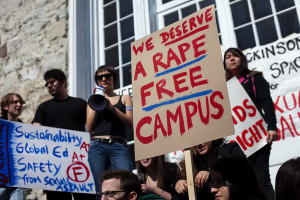 In January, President Obama established the White House Task Force to Protect Students from Sexual Assault. The members of this task force (which include the Attorney General, Secretary of the Interior, Secretary of Health and Human Services, and the Secretary of Education) have many tasks, including “providing institutions with evidence-based best and promising practices for preventing and responding to rape and sexual assault. “
In January, President Obama established the White House Task Force to Protect Students from Sexual Assault. The members of this task force (which include the Attorney General, Secretary of the Interior, Secretary of Health and Human Services, and the Secretary of Education) have many tasks, including “providing institutions with evidence-based best and promising practices for preventing and responding to rape and sexual assault. “
In the last month, many organizations have provided the Task Force feedback through listening sessions held in February and written input. From my perspective as a prevention practitioner, we need to ensure prevention, including primary prevention, is part of a comprehensive approach to addressing sexual violence on college campuses and in our communities. A comprehensive approach to prevent sexual violence incorporates diverse strategies that are culturally relevant, sustainable, responsive to community needs, and consider risk and protective factors on the individual, relationship, community and societal levels. We want prevention efforts that are informed by the best available evidence as well as fit the specific needs of the community.
When reviewing several organizations input to the community, I was alarmed when I saw the recommendations to the Task Force from RAINN that defined primary prevention in this manner: “…the most effective — the primary — way to prevent sexual violence is to use the criminal justice system to take more rapists off the streets.” While a criminal justice response is part of the solution, we cannot end rape by primarily enforcing criminal laws. I cannot think of any social problem that has been solved primarily by criminal enforcement.
In order to prevent sexual violence we need to identify community-wide solutions, not only actions that are addressing sexual assault on an individual case-by-case basis. Thus, changing culture and norms that shape behaviors are key elements to prevention. I do not see the value of labeling efforts to end rape culture as an “unfortunate trend” as RAINN does in their recommendations. Finding ways to effectively transform rape culture is a necessary piece of the change we seek.
I recommend comprehensive community-based solutions. In February, I had the opportunity to speak about prevention at the UVA Dialogue on Sexual Misconduct Among College Students. I described how effort to prevent sexual violence should include all of these elements:
- Services: Provide victim-centered supportive services to survivors of sexual violence and those impacted by violence by sexual violence, and dedicate sufficient resources to support individual and community healing.
- Systems: Build effective responses, services and systems response to sexual violence incidents to provide consistent community and social sanctions for perpetrators of violence.
- Awareness: Conduct efforts to engage the community in dialogue around sexual violence as a serious community issue, raising the profile of the problem of sexual violence, and making it relevant to individual and community lived experience. This includes efforts toward public safety that focus on helping individuals and communities managing the existing conditions that facilitate sexual violence. Such safety efforts can include publicizing available resources, individual empowerment strategies, and community safety plans.
- Primary Prevention: Implement strategies that seek to develop healthy, robust, and just communities crucial to interrupt the culture in which sexual violence thrives. These strategies promote the norms and behaviors that support a community without sexual violence.
We cannot lose sight of primary prevention efforts. I agree with RAINN that we should not mandate the use of specific curricula toward preventing sexual violence as each college and community needs to find the strategies that best meet thier specific needs and build upon the assets of that community. However, I do not agree with RAINN that “research has shown that prevention efforts that focus solely on men and “redefining masculinity,” …are unlikely to be effective.” Sexual Violence Research Initiative’s 2011 Report Engaging Boys and Men in the Prevention of Sexual Violence and other research indicate many strategies that have promise in reducing sexual violence perpetration.
I wish sexual violence could be prevented with a video, brochure, or pre-packaged program. However, we need to dedicate a range of activities, that includes activities that RAINN calls for, and comprehensive prevention efforts to create colleges and communities without rape.
Photo from Her Campus.

